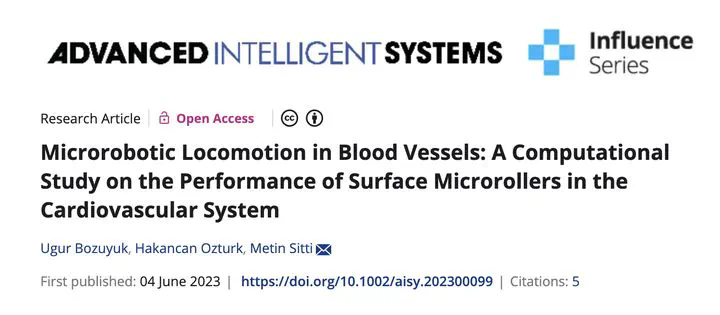Abstract
Magnetic surface microrollers possess a significant potential for controlled navigation in blood vessels owing to their strong locomotion capability and minimized flow velocities at the vessel walls to revolutionize localized drug/gene delivery. However, the circulatory system consists of many vessels significantly different from each other in terms of dimensions and flow speeds. There are different flow regimes (i.e., laminar or turbulent), types (pulsatile or continuous), and dimensions (cell-sized or macroscopic), which render different fluidic effects in blood vessels. Overall, understanding the navigation capability of surface microrollers in various types of vessels is crucial for the practical implementation of the system for future biomedical applications. Here, we investigated the upstream locomotion potential of surface microrollers inside different blood vessels with computational fluid dynamics (CFD) analyses. We studied all vessel types in the systemic circulation except the aorta and vena cava. The microrollers demonstrate successful upstream locomotion ability in veins and partially in arteries but fail to perform in smaller blood vessels due to significant confinement and flow effects. Overall, the results presented here establish a preliminary result for the future in vivo use of surface microrollers.
Type
Publication
Advanced Intelligent Systems, 5(2300099)
Surface microrollers have emerged as a promising microrobotic platform for navigation in the circulatory system as future drug/gene delivery applications. The circulatory system comprises various vessels with different dimensions, blood flow velocities, and flow regimes. Therefore, the performance of surface microrollers would vary in blood vessels. Herein, the performance of surface microrollers, with diameters between 5 and 50 μm, inside vessels of the systemic circulation including veins, venules, capillaries, arterioles, and arteries is investigated with computational fluid dynamics simulations. The simulation environment consists of a simplified fluid with the viscosity and density of blood, without red blood cells, in a cylindrical pipe. The microrollers demonstrate successful upstream locomotion ability in veins and partially in arteries but fail to perform in smaller blood vessels due to significant confinement and flow effects. Overall, the results presented here establish a preliminary result for the future in vivo use of surface microrollers.
